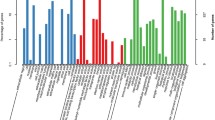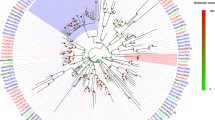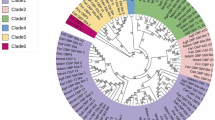Abstract
Odorant-binding proteins (OBPs) and chemosensory proteins (CSPs) in insects play an important role in mating and oviposition host selection. A plant bug, Yemma signatus is a Hemiptera omnivorous insect that feeds on plants and small insects, but little chemical communication information is available on this species. Here, using antennal transcriptome data from Y. signatus, 22 OBPs (19 ‘Classic’ OBPs and three ‘Plus-C’ OBPs) and 14 CSPs were identified. The expression profiles of these putative OBP and CSP genes were examined using real-time quantitative PCR. Our results revealed that OBP and CSP genes were mainly expressed in male and female antennae of Y. signatus. Only YsigCSP10 was more highly expressed in body parts than in the antennae of both sexes. Our study provides valuable biological information for studying olfactory communication systems in Y. signatus.






Similar content being viewed by others
References
Bian, L., Li, Z. Q., Ma, L., Cai, X. M., Luo, Z. X., & Chen, Z. M. (2018). Identification of the genes in tea leafhopper, Empoasca onukii (Hemiptera: Cicadellidae), that encode odorant-binding proteins and chemosensory proteins using transcriptome analyses of insect heads. Applied Entomology and Zoology, 53, 93–105.
Bruyne, M., & Baker, T. C. (2008). Odor detection in insects: volatile codes. Journal of Chemical Ecology, 34, 882–897.
Calvello, M., Brandazza, A., Navarrini, A., Dani, F. R., Turillazzi, S., Felicioli, A., & Pelosi, P. (2005). Expression of odorant-binding proteins and chemosensory proteins in some Hymenoptera. Insect Biochemistry and Molecular Biology, 35, 297–307.
Claridge-Chang, A., Wijnen, H., Naef, F., Boothroyd, C., Rajewsky, N., & Young, M. W. (2001). Circadian regulation of gene expression systems in the Drosophila head. Neuron, 32, 657–671.
Cui, H. H., Gu, S. H., Zhu, X. Q., Wei, Y., Liu, H. W., Khalid, H. D., et al. (2017). Odorant-binding and chemosensory proteins identified in the antennal transcriptome of Adelphocoris suturalisJakovlev. Comparative Biochemistry and Physiology, 24, 139–145.
Dani, F. R., Iovinella, I., Felicioli, A., Niccolini, A., Calvello, M. A., Carucci, M. G., Qiao, H., Pieraccini, G., Turillazzi, S., Moneti, G., & Pelosi, P. (2010). Mapping the expression of soluble olfactory proteins in the honeybee. Journal of Proteome Research, 9, 1822–1833.
Dyanov, H., & Dzitoeva, S. (1995). Method for attachment of microscopic preparations on glass for in situ hybridization, PRINS and in situ PCR studies. BioTechniques, 18, 822–826.
Ehret-Sabatier, L., Jouanguy, E., Dostert, C., & Zachary, D. (2003). Pherokine-2 and -3: Two Drosophila molecules related to pheromone/odor-binding proteins induced by viral and bacterial infection. European Journal of Biochemistry, 270, 3398–3407.
Forêt, S., Wanner, K. W., & Maleszka, R. (2007). Chemosensory proteins in the honey bee: Insights from the annotated genome, comparative analyses and expressional profiling. Insect Biochemistry and Molecular Biology, 37, 19–28.
Gong, L., Luo, Q., Rizwan-ul-Haq, M., & Hu, M. Y. (2012). Cloning and characterization of three chemosensory proteins from Spodoptera exigua and effects of gene silencing on female survival and reproduction. Bulletin of Entomological Research, 102, 600–609.
Gong, Z. J., Zhou, W. W., Yu, H. Z., Mao, C. G., Zhang, C. X., Cheng, J. A., & Zhu, Z. R. (2009). Cloning, expression and functional analysis of a general odorant-binding protein 2 gene of the rice striped stem borer, Chilo suppressalis (Walker) (Lepidoptera: Pyralidae). Insect Molecular Biology, 18, 405–417.
Gouy, M., Guindon, S., & Gascuel, O. (2010). SeaView Version 4: A multiplatform graphical user interface for sequence alignment and phylogenetic tree building. Molecular Biology and Evolution, 27, 221–224.
Grabherr, M. G., Haas, B. J., Yassour, M., Levin, J. Z., Thompson, D. A., Amit, I., Adiconis, X., Fan, L., Raychowdhury, R., Zeng, Q., Chen, Z., Mauceli, E., Hacohen, N., Gnirke, A., Rhind, N., Palma, F., Birren, B. W., Nusbaum, C., Lindblad-Toh, K., … Regev, A. (2011). Full-length transcriptome assembly from RNA-Seq data without a reference genome. Nature Biotechnology, 29, 644–652.
Gu, S. H., Wang, S. P., Zhang, X. Y., Wu, K. M., Guo, Y. Y., Zhou, J. J., & Zhang, Y. J. (2011). Identification and tissue distribution of odorant binding protein genes in the lucerne plant bug Adelphocoris lineolatus (Goeze). Insect Biochemistry Molecular, 41, 254–263.
Gu, S. H., Wang, S. Y., Zhang, X. Y., Ji, P., Liu, J. T., Wang, G. R., Wu, K. M., Guo, Y. Y., Zhou, J. J., & Zhang, Y. J. (2012). Functional characterizations of chemosensory proteins of the alfalfa plant bug Adelphocoris lineolatus indicate their involvement in host recognition. PLoS ONE, 7, e42871.
He, P., Zhang, J., Liu, N. Y., Zhang, Y. N., Yang, K., & Dong, S. L. (2011). Distinct expression profiles and different functions of odorant binding proteins in Nilaparvata lugensStål. PLoS ONE, 6, e28921.
Hua, J. F., Zhang, S., Cui, J. J., Wang, D. J., Wang, C. Y., Luo, J. Y., Lv, L. M., & Ma, Y. (2013). Functional characterizations of one odorant binding protein and three chemosensory proteins from Apolygus lucorum (Meyer-Dur) (Hemiptera: Miridae) legs. Journal of Insect Physiology, 59, 690–696.
Hull, J. J., Perera, O. P., & Snodgrass, G. L. (2014). Cloning and expression profiling of odorant-binding proteins in the tarnished plant bug Lygus lineolaris. Insect Molecular Biology, 23, 78–97.
Hull, J., Perera, O. P., & Wang, M. X. (2018). Molecular cloning and comparative analysis of transcripts encoding chemosensory proteins from two plant bugs, Lygus lineolaris and Lygus hesperus. Insect Science, 3, 404–424.
Jacquin-Joly, E., Vogt, R. G., Francois, M. C., & Nagnan-Le Meillour, P. (2001). Functional and expression pattern analysis of chemosensory proteins expressed in antennae and pheromonal gland of Mamestra brassicae. Chemical Senses, 26, 833–844.
Jiang, X., Pregitzer, P., Grosse-Wilde, E., Breer, H., & Krieger, J. (2016). Identification and characterization of two “sensory neuron membrane proteins” (SNMPs) of the desert locust, Schistocerca gregaria (Orthoptera: Acrididae). Journal of Insect Science, 16, 33.
Jin, X., Brandazza, A., Navarrini, A., Ban, L., Zhang, S., Steinbrecht, R. A., Zhang, L., & Pelosi, P. (2005). Expression and immunolocalisation of odorantbinding and chemosensory proteins in locusts. Cellular and Molecular Life Sciences, 62, 1156–1166.
Ju, Q., Li, X., Jiang, X. J., Qu, M. J., Guo, X. Q., Han, Z. J., & Li, F. (2014). Transcriptome and tissue-specific expression analysis of OBP and CSP genes in the dark black chafer. Archives of Insect Biochemistry and Physiology, 87, 177–200.
Kitabayashi, A. N., Arai, T., Kubo, T., & Natori, S. (1998). Molecular cloning of cDNA for p10, a novel protein that increases in the regenerating legs of Periplaneta americana (American cockroach). Insect Biochemistry and Molecular Biology, 28, 785–790.
Kulmuni, J., & Havukainen, H. (2013). Insights into the evolution of the CSP gene family through the integration of evolutionary analysis and comparative protein modeling. PLoS ONE, 8, e63688.
Kuraku, S., Zmasek, C. M., Nishimura, O., & Katoh, K. (2013). aLeaves facilitates on-demand exploration of metazoan gene family trees on MAFFT sequence alignment server with enhanced interactivity. Nucleic Acids Research, 41, 22–28.
Kwon, J. Y., Dahanukar, A., Weiss, L. A., & Carlson, J. R. (2007). The molecular basis of CO2 reception in Drosophila. Proceedings of the National academy of Sciences of the United States of America, 104, 3574–3578.
Leal, W. S. (2013). Odorant reception in insects: roles of receptors. Annual Review of Entomology, 58, 373–391.
Levy, F., Bulet, P., & Ehret-Sabatier, L. (2004). Proteomic analysis of the systemic immune response of Drosophila. Biochimie, 86, 607–616.
Li, S., Picimbon, J. F., Ji, S., Kan, Y., Qiao, C., Zhou, J. J., & Pelosi, P. (2008). Multiple functions of an odorant-binding protein in the mosquito Aedes aegypti. Biochemical Biophysical Research Communications, 372, 464–468.
Liang, L. J., Miao, G. X., & Xing, B. Q. (1992). Study on the predatory function of Yemma signatus. Journal of Hebei Forestry Science and Technology, 2, 39–42.
Liu, X. L., Luo, Q., Zhong, G. H., Rizwan-Ul-Haq, M., & Hu, M. Y. (2010). Molecular characterization and expression pattern of four chemosensory proteins from diamondback moth, Plutella xylostella (Lepidoptera: Plutellidae). Journal of Biochemistry, 2, 189–200.
Liu, S., Rao, X. J., Li, M. Y., Feng, M. F., He, M. Z., & Li, S. G. (2015). Identification of candidate chemosensory genes in the antennal transcriptome of Tenebrio molitor (Coleoptera: Tenebrionidae). Comparative Biochemistry and Physiology Part D, 13, 44–51.
Liu, N. Y., Zhu, J. Y., Ji, M., Yang, B., & Ze, S. Z. (2017). Chemosensory genes from Pachypeltis micranthus, a natural enemy of the climbing hemp vine. Journal of Asia-Pacific Entomology, 20, 655–664.
Livak, K. J., & Schmittgen, T. D. (2001). Analysis of relative gene expression data using real-time quantitative PCR and the 2(T) (-ΔΔC) method. Methods, 25, 402–408.
Maleszka, J., Forêt, S., Saint, R., & Maleszka, R. (2007). RNAi-induced phenotypes suggest a novel role for a chemosensory protein CSP5 in the development of embryonic integument in the honeybee (Apis mellifera). Development Genes and Evolution, 217, 189–196.
Maleszka, R., & Stange, G. (1997). Molecular cloning, by a novel approach, of a cDNA encoding a putative olfactory protein in the labial palps of the moth Cactoblastis cactorum. Gene, 202, 39–43.
Nagnan-Le, M. P., Cain, A. H., Jacquin-Joly, E., Francois, M. C., Ramachandran, S., & Maida, R. (2000). Chemosensory proteins from the proboscis of Mamestra brassicae. Chemical Senses, 25, 541–553.
Nomura, A., Kawasaki, K., Kubo, T., & Natori, S. (1992). Purification and localization of p10, a novel protein that increases in nymphal regenerating legs of Periplaneta americana (American cockroach). International Journal of Developmental Biology, 36, 391–398.
Paula, D. P., Toqawa, R. C., Costa, M. M., & GrynberqMartins, Andow, P. N. F. D. A. (2016). Identification and expression profile of odorant-binding proteins in Halyomorpha halys (Hemiptera: Pentatomidae). Insect Molecular Biology, 25, 580–594.
Pelosi, P., Iovinella, I., Felicioli, A., & Dani, F. R. (2014). Soluble proteins of chemical communication: an overview across arthropods. Frontiers in Physiology, 5, 320.
Pelosi, P., Zhou, J. J., Ban, L., & Calvello, M. (2006). Soluble proteins in insect chemical communication. Cellular and Molecular Life Sciences, 63, 1658–1676.
Peng, Y., Wang, S. N., Li, K. M., Liu, J. T., Zheng, Y., Shan, S., Yang, Y. Q., Li, R. J., Zhang, Y. J., & Guo, Y. Y. (2017). Identification of odorant binding proteins and chemosensory proteins in Microplitis mediator as well as functional characterization of chemosensory protein 3. PLoS ONE, 12, e0180775.
Su, C. Y., Menuz, K., & Carlson, J. R. (2009). Olfactory perception: Receptors, cells, and circuits. Cell, 139, 45–59.
Suh, E., Bohbot, J., & Zwiebel, L. J. (2015). Peripheral olfactory signaling in insects. Current Opinion Insect Science, 6, 86–92.
Sun, L., Zhou, J. J., Gu, S. H., Xiao, H. J., Guo, Y. Y., Liu, Z. W., & Zhang, Y. J. (2015). Chemosensillumimmunolocalization and ligand specificity of chemosensory proteins in the alfalfa plant bug Adelphocoris lineolatus (Goeze). Science Reports-United Kingdom, 5, 8073.
Sun, Y. F., Biasio, F. D., Qiao, H. L., Iovinella, I., Yang, S. X., Ling, Y., Riviello, L., Battaglia, D., Falabella, P., Yang, X. L., & Pelosi, P. (2012a). Two odorant binding proteins mediate the behavioural response of aphids to the alarm pheromone (E)-β-arnesene and structural analogues. PLoS ONE, 7, e32759.
Sun, Y. L., Huang, L. Q., Pelosi, P., & Wang, C. Z. (2012b). Expression in antennae and reproductive organs suggests a dual role of an odorant-binding protein in two sibling Helicoverpa species. PLoS ONE, 7, e30040.
Touhara, K., & Vosshall, L. B. (2009). Sensing odorants and pheromones with chemosensory receptors. Annual Review of Physiology, 71, 307–332.
Venthur, H., & Zhou, J. J. (2018). Odorant receptors and odorant-binding proteins as insect pest control targets: A comparative analysis. Frontiers in Physiology, 9, 1163.
Vieira, F. G., & Rozas, J. (2011). Comparative 430 genomics of the odorant-binding and chemosensory protein gene families across the Arthropoda: origin and evolutionary history of the chemosensory system. Genome Biology and Evolution, 3, 476–490.
Wang, G. Y., Zhu, M. F., Jiang, Y. D., Zhou, W. W., Liu, S., Heong, K. L., Cheng, J., & Zhu, Z. R. (2017a). Identification of candidate odorant-binding protein and chemosensory protein genes in Cyrtorhinus lividipennis (Hemiptera: Miridae), a key predator of the rice planthoppers in Asia. Environmental Entomology, 46, 654–662.
Wang, R., Li, F., Zhang, W., Zhang, X., Qu, C., Tetreau, G., Luo, C., & Zhou, J. (2017b). Identification and expression profile analysis of odorant binding protein and chemosensory protein genes in Bemisia tabaci MED by head transcriptome. PLoS ONE, 12, e0171739.
Wanner, K. W., Willis, L. G., Theilmann, D. A., Isman, M. B., Feng, Q. L., & Plettner, E. (2004). Analysis of the insect OS-D-like gene family. Journal of Chemical Ecology, 30, 889–911.
Xiao, Y., Sun, L., Wang, Q., & Zhang, Q. (2018). Molecular characterization and expression analysis of putative odorant carrier proteins in Adelphocoris lineolatus. Journal of Asia-Pacific Entomology, 21, 958–970.
Yang, Y. Q. (1982). Two insect of feeding Paulownia. Chinese Journal of Applied Entomology, 1, 22–23.
Yang, K., Liu, Y., Niu, D. J., Wei, D., Li, F., Wang, G. R., & Dong, S. L. (2016). Identification of novel odorant binding protein genes and functional characterization of OBP8 in Chilo suppressalis (Walker). Gene, 591, 425–432.
Ye, J., Coulouris, G., Zaretskaya, I., Cutcutache, I., Rozen, S., & Madden, T. L. (2012). Primer-BLAST: A tool to design target-specific primers for polymerase chain reaction. BMC Bioinformatics, 13, 134.
Yi, X., Zhao, H. M., Wang, P. D., Hu, M. Y., & Zhong, G. H. (2014). BdorOrco is important for oviposition-deterring behavior induced by both the volatile and non-volatile repellents in Bactrocera dorsalis (Diptera: Tephritidae). Journal of Insect Physiology, 65, 51–56.
Yuan, H. B., Ding, Y. X., Gu, S. H., Sun, L., Zhu, X. Q., Liu, H. W., Dhiloo, K. H., Zhang, Y. J., & Guo, Y. Y. (2015). Molecular characterization and expression profiling of odorant-binding proteins in Apolygus lucorum. PLoS ONE, 10, e0140562.
Zeng, F. F., Liu, H., Zhang, A., Lu, Z. X., Leal, W.S., Abdelnabby, H., & Wang, M. Q. (2018). Three chemosensory proteins from the rice leaf folder Cnaphalocrocis medinalis involved in host volatile and sex pheromone reception. Insect Molecular Biology, 27, 710–723.
Zhang, Y. N., Jin, J. Y., Jin, R., Xia, Y. H., Zhou, J. J., Deng, J. Y., & Dong, S. L. (2013). Differential expression patterns in chemosensory and non-chemosensory tissues of putative chemosensory genes identified by transcriptome analysis of insect pest the purple stem borer Sesamia inferens (Walker). PLoS ONE, 8, e69715.
Zhang, Y. N., Zhu, X. Y., Zhang, Q., Yin, C. Y., Dong, Z. P., Zuo, L. H., et al. (2016). De novo assembly and characterization of antennal transcriptome reveal chemosensory system in Nysius ericae. Journal of Asia Pacific Entomology, 19, 1077–1087.
Zhang, Y. N., Ye, Z. F., Yang, K., & Dong, S. L. (2014). Antenna-predominant and male-biased CSP19 of Sesamia inferens is able to bind the female sex pheromones and host plant volatiles. Gene, 536, 279–286.
Zhou, J. J. (2010). Odorant-binding proteins in insects. Vitamins and Hormones, 83, 241–272.
Zhou, S. H., Zhang, J., Zhang, S. G., & Zhang, L. (2008). Expression of chemosensory proteins in hairs on wings of Locusta migratoria (Orthoptera: Acrididae). Journal of Applied Entomology, 132, 439–450.
Zhou, J. J., Robertson, G., He, X., Dufour, S., Hooper, A. M., Pickett, J. A., Keep, N. H., & Field, L. M. (2009). Characterisation of Bombyx mori odorant binding proteins reveals that a general odorant-binding protein discriminates between sex pheromone components. Journal of Molecular Biology, 389, 529–545.
Zhou, J. J., Vieira, F. G., He, X. L., Smadja, C. M., Liu, R., Rozas, J., & Field, L. M. (2010). Genome annotation and comparative analyses of the odorant-binding proteins in Acyrthosiphon pisum. Insect Molecular Biology, 19, 113–122.
Zhou, S. S., Sun, Z., Ma, W., Chen, W., & Wang, M. Q. (2014). De novo analysis of the Nilaparvata lugens (Stål) antenna transcriptome and expression patterns of olfactory genes. Comparative Biochemistry Physiology D, 9, 31–39.
Acknowledgements
This research was supported by Natural Science Foundation of China (31701788) and Science and Technology Project in Henan Province (202102110069).
Author information
Authors and Affiliations
Corresponding author
Ethics declarations
Conflict of interest
There is no conflict of interest between the authors.
Additional information
Publisher's Note
Springer Nature remains neutral with regard to jurisdictional claims in published maps and institutional affiliations.
Supplementary Information
Below is the link to the electronic supplementary material.
Rights and permissions
About this article
Cite this article
Song, Y., Song, Z., Gu, H. et al. Identification and expression analysis of odorant-binding proteins and chemosensory proteins in the antennal transcriptome of Yemma signatus (Hsiao, 1974). Phytoparasitica 49, 917–933 (2021). https://doi.org/10.1007/s12600-021-00917-9
Received:
Accepted:
Published:
Issue Date:
DOI: https://doi.org/10.1007/s12600-021-00917-9




